Building a backyard futsal field transforms your outdoor space into a versatile sports hub that provides year-round entertainment, fitness opportunities, and property value enhancement. With proper planning and material selection, you can create a professional-quality playing surface that rivals commercial facilities.
Creating your own futsal field represents more than just adding a sports facility to your property. It establishes a foundation for family bonding, skill development, and community engagement right in your backyard. As a production process engineer who has overseen countless sports facility installations, I’ve witnessed firsthand how the right approach to planning and execution makes the difference between a successful project and costly mistakes.
The key lies in understanding that futsal fields require specific dimensional considerations, drainage solutions, and surface materials that differ significantly from traditional soccer fields. Modern installation techniques now allow homeowners to achieve professional-grade results without the complexity and expense traditionally associated with sports facility construction.
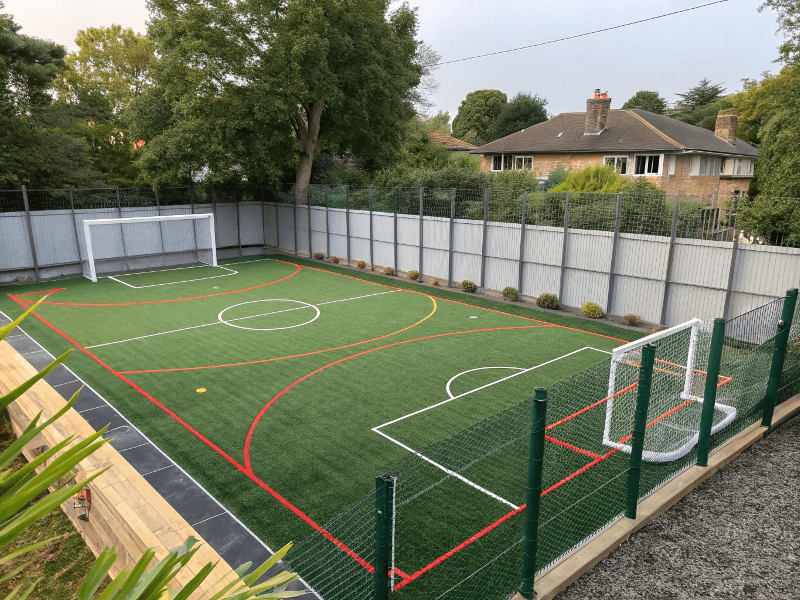
Your journey from concept to completion requires careful attention to detail, but the rewards extend far beyond the initial investment. Let me walk you through each critical phase of this exciting project.
Why Should You Build a Home Futsal Court?
A home futsal court offers unmatched convenience for skill development, eliminates booking fees and travel time, while creating a social hub that enhances property value and promotes family fitness activities.
Unparalleled Convenience and Accessibility
The primary advantage of owning a home futsal court centers on immediate access. No more coordinating schedules with facility availability or dealing with weather-related cancellations at public venues. Your field remains ready for spontaneous games, structured practice sessions, or casual kickabouts whenever the mood strikes.
This convenience factor particularly benefits families with young athletes. Children can practice daily fundamentals like ball control, passing accuracy, and shooting technique without the pressure of formal training environments. The consistent surface conditions allow players to develop muscle memory and technical skills more effectively than constantly adapting to different playing surfaces.
Investment Returns and Property Enhancement
Beyond recreational benefits, a well-constructed futsal field significantly increases property appeal and market value. Real estate professionals consistently report that unique outdoor amenities distinguish properties in competitive markets. A professionally installed sports facility demonstrates quality home improvements that potential buyers recognize and value.
The investment typically recovers its cost through eliminated facility rental fees within 2-3 years for active families. Additionally, the durability of modern field materials ensures decades of use with minimal maintenance requirements.
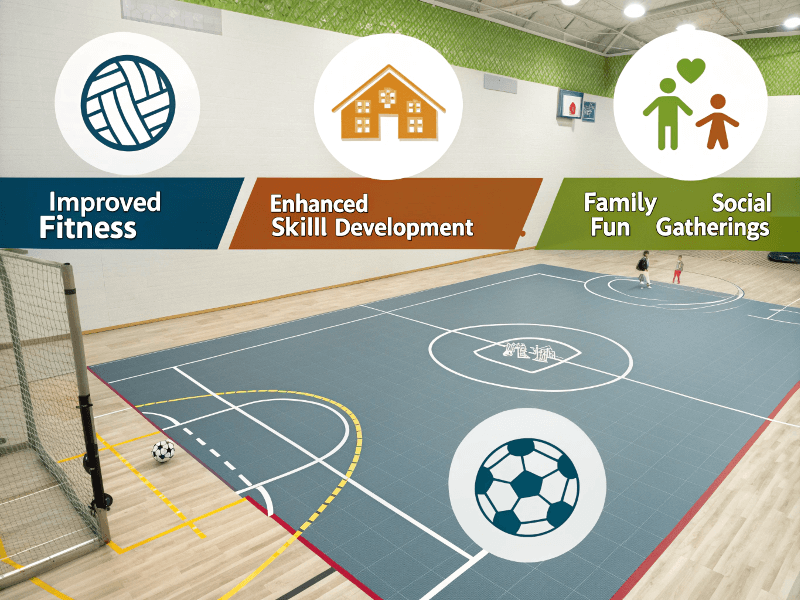
The social dynamics created by a home futsal court extend beyond immediate family use. These spaces naturally become gathering points for neighborhood activities, birthday celebrations, and community events that strengthen social connections while providing healthy entertainment alternatives.
What Are the Essential Planning Requirements for Your Futsal Field?
Successful futsal field construction requires minimum dimensions of 25m x 16m, proper drainage planning, local permit compliance, and budget allocation for surface materials, goals, perimeter fencing, and optional lighting systems.
Space Assessment and Regulatory Compliance
The foundation of any successful futsal field project begins with accurate space measurement and regulatory research. Standard futsal dimensions require 25 meters length by 16 meters width for optimal play, though smaller adaptations work for recreational use. However, you’ll need additional perimeter space for safety zones and potential fencing installation.
Local building codes often regulate permanent sports installations, particularly regarding setback requirements from property lines, drainage impact on neighboring properties, and structure height limitations. Many jurisdictions require permits for concrete work, electrical installations, or fencing above certain heights. Contact your local building department early in the planning process to avoid costly modifications later.
Budget Planning and Cost Structure
| Cost Category | Budget Range | Основные соображения |
|---|---|---|
| Site Preparation | $2,000-$5,000 | Excavation, leveling, drainage |
| Base Construction | $3,000-$8,000 | Concrete or aggregate base |
| Surface Material | $4,000-$12,000 | Varies by material choice |
| Goals and Equipment | $500-$2,000 | Fixed vs. portable options |
| Perimeter Fencing | $2,000-$6,000 | Height and material dependent |
| Lighting (Optional) | $1,500-$4,000 | LED sports lighting systems |
Professional installation typically adds 30-50% to material costs but ensures proper drainage, surface preparation, and compliance with local codes. DIY approaches can reduce labor costs but require careful attention to technical specifications and local regulations.
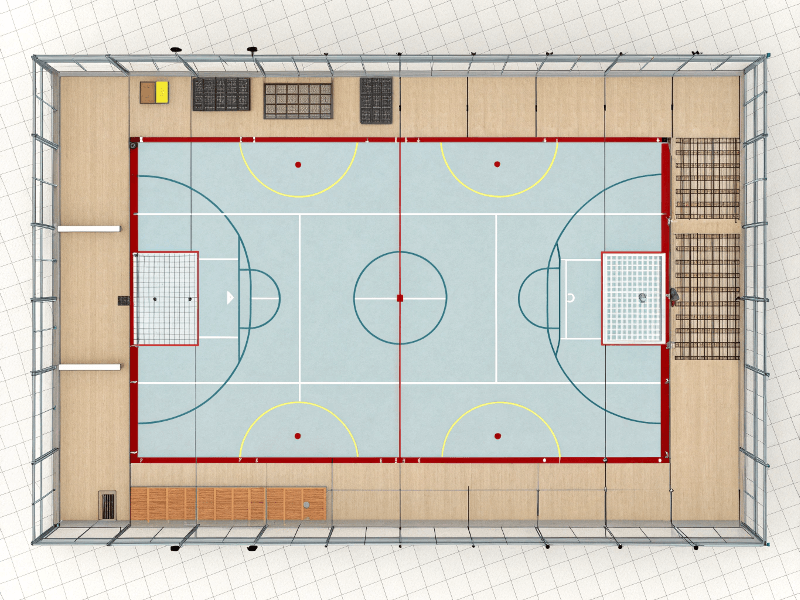
The total investment ranges from $12,000-$35,000 depending on size, material choices, and installation complexity. This represents significant savings compared to annual facility rental costs for active families while providing superior convenience and customization options.
Which Surface Material Best Suits Your Futsal Field Needs?
Non-infill artificial turf provides the optimal balance of performance, safety, and maintenance for home futsal courts, eliminating the health concerns and upkeep issues associated with traditional sand-filled surfaces while delivering professional-grade playing characteristics.
Understanding Surface Material Options
The choice of playing surface fundamentally impacts your field’s performance, safety, and maintenance requirements. Traditional options include concrete or asphalt with painted lines, modular interlocking tiles, and artificial turf systems. Each material offers distinct advantages and limitations that affect long-term satisfaction and costs.
Concrete surfaces provide excellent ball response and durability but create safety concerns due to hardness and potential for serious injuries during falls. The rigid surface also generates more stress on players’ joints during extended play sessions. While initially less expensive, concrete requires regular maintenance to prevent cracking and surface deterioration.
The Revolution of Non-Infill Artificial Turf
Modern non-infill artificial turf represents a breakthrough in sports surface technology. Unlike traditional infill systems that require sand and rubber granule filling, these advanced surfaces achieve optimal playing characteristics through engineered fiber design and specialized backing systems.
The elimination of infill materials addresses multiple concerns that plague traditional artificial turf installations. Players no longer experience sand or rubber particles entering shoes, eyes, or respiratory systems during play. The absence of loose materials also eliminates the ongoing maintenance challenges of infill redistribution and replacement.
| Performance Aspect | Non-Infill Turf | Traditional Infill Turf | Concrete Surface |
|---|---|---|---|
| Ball Response | Превосходно | Хорошо | Превосходно |
| Player Safety | Superior | Умеренный | Бедный |
| Техническое обслуживание | Минимум | Высокий | Умеренный |
| Время установки | Быстрый | Умеренный | Slow |
| Устойчивость к погодным условиям | Превосходно | Хорошо | Бедный |
The advanced fiber technology in non-infill systems provides consistent ball roll characteristics that closely mimic natural grass while maintaining the durability advantages of synthetic materials. The engineered backing systems deliver appropriate shock absorption to reduce injury risk while maintaining the surface stability required for quick directional changes.
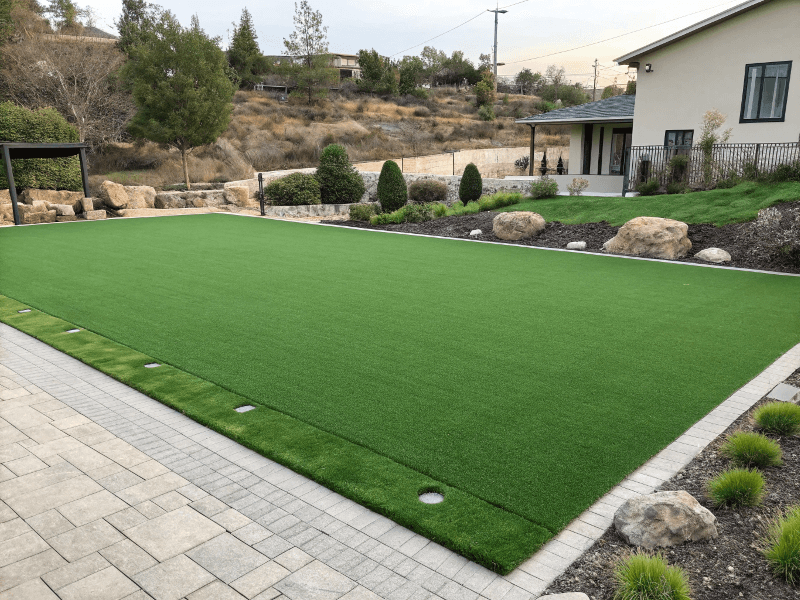
Environmental considerations also favor non-infill systems. The absence of loose particles eliminates concerns about material migration into surrounding landscapes or water systems. The recyclable nature of modern synthetic materials supports sustainable construction practices while extending the useful life of the installation.
How Do You Execute Professional-Quality Installation?
Professional futsal field installation follows a systematic process: site preparation with proper drainage, base construction using compacted materials, surface installation with precise measurements, and integration of goals, fencing, and lighting systems for complete functionality.
Site Preparation and Foundation Work
The success of your futsal field depends critically on proper site preparation and foundation construction. This phase requires careful attention to drainage design, soil conditions, and grade establishment to ensure long-term performance and prevent costly repairs.
Begin by excavating the area to remove organic materials and achieve proper depth for your chosen base system. Most installations require 4-6 inches of excavation to accommodate base materials and ensure proper elevation relative to surrounding areas. The excavation should extend beyond the playing surface dimensions to provide adequate edge support.
Proper drainage design prevents water accumulation that can damage the playing surface and create unsafe conditions. Install perimeter drainage systems where necessary and establish a gentle slope (typically 1-2% grade) to direct water away from the playing area. In areas with heavy rainfall, consider subsurface drainage systems to prevent hydrostatic pressure issues.
Surface Installation Techniques
The installation process varies significantly based on your chosen surface material, but several principles apply universally. Accurate measurements and precise line marking ensure proper field dimensions and professional appearance. Use high-quality marking materials designed for sports applications to ensure durability and visibility.
For non-infill artificial turf installations, proper seaming techniques and adhesive application create invisible joints that maintain consistent playing characteristics across the entire surface. The turf backing must be properly secured to prevent shifting or lifting during play. Professional installation tools ensure proper tension and alignment throughout the process.
Integration of Essential Components
| Component | Installation Priority | Основные соображения |
|---|---|---|
| Goals | Высокий | Fixed vs. portable options |
| Perimeter Fencing | Высокий | Safety and ball containment |
| Lighting | Средний | Energy efficiency and light distribution |
| Drainage | Критический | Prevents surface damage |
| Line Marking | Высокий | Accurate field dimensions |
Goal installation requires careful consideration of safety and functionality. Fixed goals provide stability and professional appearance but limit field versatility. Portable systems offer flexibility for multi-sport use but require secure anchoring during play to prevent accidents.
Perimeter fencing serves dual purposes of ball containment and safety protection. Height recommendations vary from 3-6 feet depending on surrounding structures and intended use intensity. Consider mesh size and material durability when selecting fencing systems.
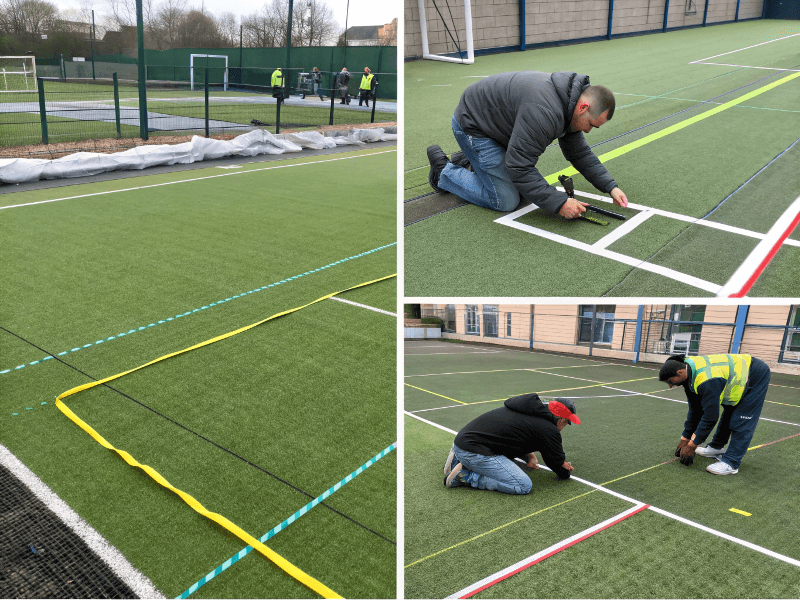
Lighting systems extend playing hours and increase field utilization value. LED sports lighting provides energy efficiency and superior light distribution compared to traditional systems. Proper lighting design eliminates shadows and glare while meeting recommended illumination levels for safe play.
What Maintenance Practices Ensure Long-Term Performance?
Effective futsal field maintenance involves regular surface cleaning, periodic inspection for wear patterns, prompt repair of minor damage, and seasonal preparation to maximize surface life and maintain optimal playing conditions.
Daily and Weekly Maintenance Routines
Consistent maintenance practices preserve your investment and ensure safe playing conditions. Daily activities include removing debris, leaves, and foreign objects that can damage the surface or create safety hazards. Weekly cleaning with appropriate tools and cleaning solutions maintains surface appearance and prevents buildup of organic materials.
For non-infill artificial turf surfaces, maintenance requirements are significantly reduced compared to traditional infill systems. The absence of loose materials eliminates the need for regular brushing and infill redistribution that characterizes traditional installations. Simple cleaning with water removes most contamination and restores surface appearance.
Inspect drainage systems regularly to ensure proper function, particularly after heavy rainfall or extreme weather events. Clear blocked drains promptly to prevent water accumulation that can damage the playing surface or create unsafe conditions.
Seasonal Maintenance and Long-Term Care
| Season | Maintenance Focus | Specific Tasks |
|---|---|---|
| Spring | Глубокая очистка | Pressure washing, drain inspection |
| Summer | Heat Management | Shade consideration, surface cooling |
| Fall | Debris Removal | Leaf clearing, drain protection |
| Winter | Weather Protection | Ice removal, surface protection |
Seasonal maintenance addresses specific challenges associated with weather conditions and usage patterns. Spring cleaning removes winter accumulation and prepares the surface for increased usage. Summer maintenance focuses on heat management and UV protection to prevent premature aging of synthetic materials.
Fall preparation emphasizes debris removal and drainage system protection before winter weather arrives. Winter maintenance varies by climate but may include ice removal procedures and surface protection during extended cold periods.

Long-term care planning includes periodic professional inspections to identify potential issues before they require major repairs. Modern non-infill surfaces typically provide 10-15 years of service life with proper maintenance, representing excellent value compared to traditional surface options.
Заключение
Building a backyard futsal field creates lasting value through enhanced family recreation, skill development opportunities, and property improvement that pays dividends for years to come.
Ready to transform your backyard into a futsal paradise? Contact us today for a free consultation and sample materials. Our team provides detailed cost estimates, technical specifications, and installation guidance to make your dream field a reality. Don’t wait – start creating memories and improving your family’s active lifestyle with your own professional-quality futsal court.
